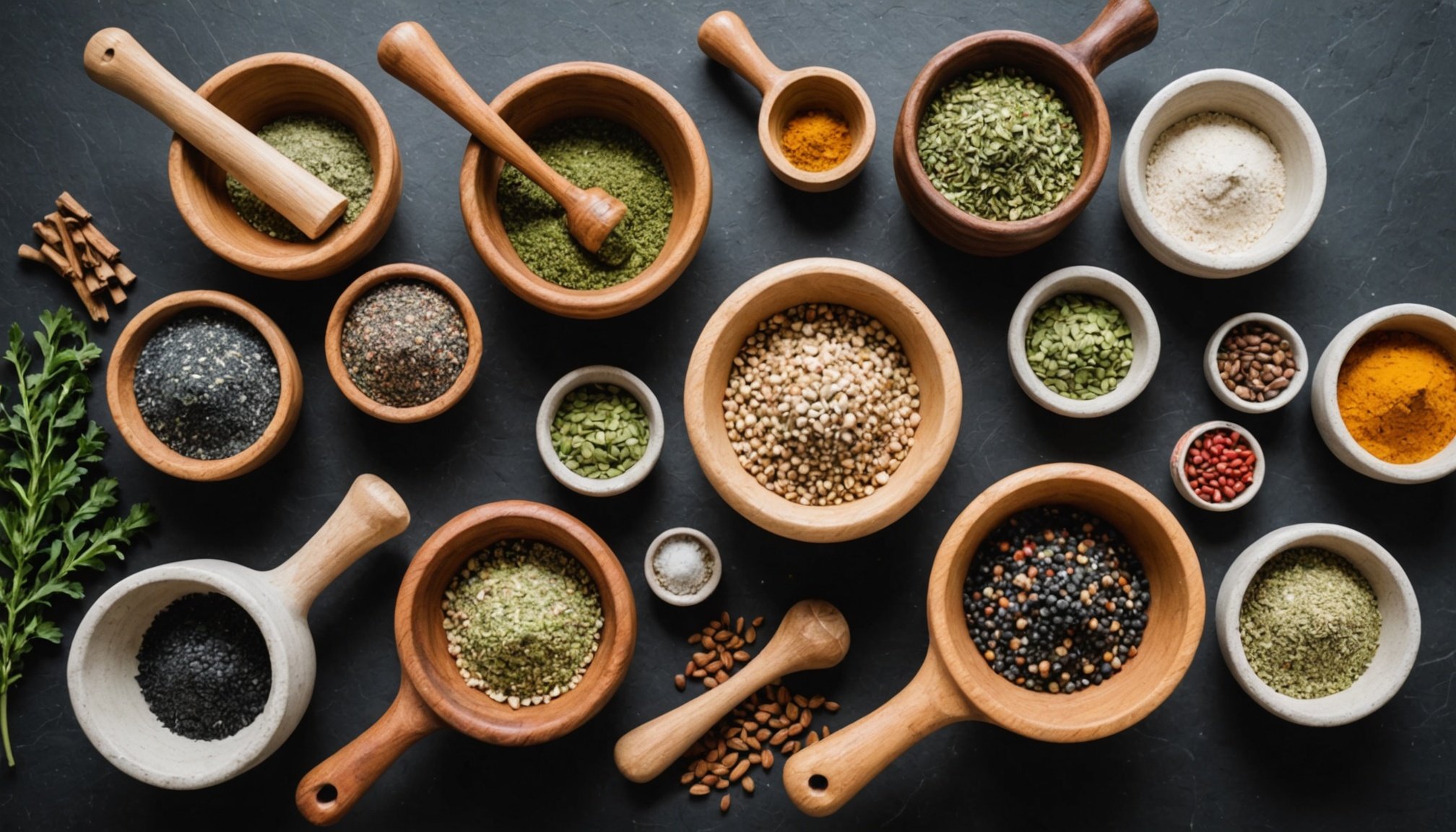Understanding Mortar and Pestle Materials
Informed choices regarding mortar and pestle materials can significantly enhance your kitchen efficiency and culinary experience. Traditionally, these culinary tools come in a variety of materials like granite, marble, ceramic, stainless steel, and wood, each offering unique benefits and drawbacks. The material choice influences not only their durability but also the flavor transfer and the effort required for food preparation.
Granite, for example, is known for its durability and effective crushing efficiency due to its rough surface. On the other hand, marble is often chosen for its aesthetic appeal and smoothness, which is gentle on delicate ingredients while offering excellent heat retention. Ceramic is lightweight and known for maintaining the flavor neutrality of ingredients, though it may lack the robustness of stone.
Have you seen this : Selecting the Perfect Bread Proofing Basket: Your Guide to Avoiding Sticky Dough
Stainless steel and wood are alternative options. Stainless steel is durable and modern, while wood is lightweight and gentle on herbs. Yet, these materials may not suit every culinary need. Considerations of how frequently you use these tools, combined with the effects on flavor and ease of maintenance, guide the perfect selection for daily cooking tasks.
Granite Mortar and Pestle
The granite mortar and pestle is a timeless choice, known for its unparalleled durability and effective crushing efficiency. Granite’s rough surface makes it highly effective for grinding various spices and harder ingredients, which enhances cooking efficiency by producing a consistent texture. The weight and sturdiness of granite allow for more effortless grinding, reducing physical strain.
Also read : Top Compact Refrigerators with Superior Built-in Freezers for Tight Spaces
Regular maintenance of a granite mortar and pestle involves simple steps to ensure longevity: wash it thoroughly with soap and water after each use, and avoid soaking to prevent the stone from weakening over time. If needed, use a stiff brush to remove stubborn residue, then allow it to air dry completely before storing.
Culinary-wise, granite excels in preparing traditional pastes, such as pesto and guacamole, because it effortlessly breaks down fibrous ingredients. It’s particularly favored for recipes that thrive on coarse textures, offering enhanced flavor extraction.
Despite granite’s robustness, users must assess individual needs. While it’s ideal for someone who frequently prepares spice blends or pestos, its heaviness could be a drawback for those seeking lightweight alternatives. Always consider the type of cooking tasks you routinely engage in when choosing your mortar and pestle material.
Marble Mortar and Pestle
Delve into the world of marble mortar and pestle, and you’ll find both beauty and functionality in the kitchen. Marble’s aesthetic appeal makes it a favourite among those who appreciate elegance. The smooth surface not only adds to its charm but also offers excellent heat retention. This characteristic is ideal for maintaining ingredient temperature, particularly in recipes requiring delicate treatment.
When comparing marble with granite, marble stands out for its gentle touch on ingredients, making it suitable for lighter, more delicate preparations. While granite excels in crushing hard spices, marble’s smoothness is perfect for softer ingredients, where a subtle flavour transfer is desirable. Its functionality does come with the need for gentle cleaning. Using warm water and a soft cloth is recommended to prevent any potential scratching or etching on the surface. For tougher residues, a mixture of baking soda and water can offer mild abrasion without damaging the marble.
In essence, a marble mortar and pestle represents more than just a pretty kitchen tool—it’s an asset for those seeking finesse in cooking. With proper care, it adds both charm and practical efficiency to culinary practices.
Ceramic Mortar and Pestle
Ceramic mortar and pestles offer a unique blend of lightweight practicality and flavor neutrality. Unlike their stone counterparts, ceramics are much easier to handle for those who may shy away from the heft of granite or marble. This aspect makes ceramics particularly favoured in kitchens where quick cooking efficiency and ease of use take precedence.
However, ceramics aren’t as robust as stone options like granite or marble. While they excel in preserving the subtle aromas and tastes of ingredients, they might not withstand the rigours of grinding harder substances, such as tough spices or large quantities of fibrous ingredients. They’re best suited for soft nuts or crushing herbs such as basil and cilantro, where maintaining the delicate flavours is crucial.
In terms of upkeep, ceramic requires simple cleaning with mild soapy water. Avoid abrasive materials to preserve the surface. Opt for drying thoroughly before storing away to prevent any residual moisture retention that could affect the quality. Thus, for those who value flavor neutrality in their culinary tools, ceramics stand as a reliable, user-friendly option despite their lower durability.
Other Materials
When exploring alternative mortar and pestle materials like stainless steel and wood, you’ll find unique characteristics and uses. While less traditional than granite or marble, these materials present distinct advantages.
Stainless steel is known for its modern appeal and resilience. It boasts impressive durability and is hygienic, making it easy to clean and resistant to staining. This makes stainless steel an excellent choice for those who value low-maintenance culinary tools. However, its smoothness may not provide the same effective crushing as more textured options.
On the other hand, wooden mortar and pestles are lightweight and gentle, suitable for herbal mixtures where the subtlety of flavour is crucial. Wood brings a rustic charm to the kitchen but requires careful care to avoid absorbing flavours and odours over time.
When deciding on alternative materials, consider your cooking style and personal preferences. For example, if you prioritise low upkeep and durability, stainless steel suits well. For those drawn to gentle grinding and a rustic aesthetic, wood is preferable. Regardless of the choice, these materials enhance cooking efficiency through their diverse benefits.
Maintenance Tips for Mortar and Pestle
Proper mortar and pestle maintenance is vital for ensuring longevity and efficiency. Depending on the material, cleaning techniques may vary significantly. For durable materials like granite, washing with soap and water suffices; however, avoid prolonged soaking to prevent weakening. A stiff brush can help eliminate tough residues.
Meanwhile, marble mortar and pestles deserve more gentle care. Using warm, soapy water with a soft cloth is ideal for maintenance, as harsh abrasives can scratch the shiny surface. Occasionally, a baking soda-water mixture offers a mild yet effective cleaning solution.
Ceramic mortar and pestles require a focus on preserving surface integrity. Mild soapy water and avoidance of abrasives are key to maintaining their finish. Thorough drying prevents moisture retention that could degrade the material over time.
For wooden mortar and pestles, oiling them regularly prevents excessive flavour absorption. Regardless of material, regular inspection for surface wear can highlight when it is time to consider a replacement. Through proper maintenance, these culinary tools maintain their functionality, enhancing your cooking experience.
Visual Comparisons of Mortar and Pestle Materials
To make an informed decision when selecting a mortar and pestle, visual aids can be highly beneficial. By comparing the material differences graphically, users gain a clearer understanding of each option’s unique attributes and how they align with individual cooking needs.
Charts offer a side-by-side comparison of durability, ease of maintenance, and flavour transfer among various materials. For instance, granite is depicted with high durability and effective crushing efficiency, while marble is illustrated for its aesthetic appeal and heat retention. Ceramic is noted for lightweight handling and flavour neutrality, though its fragility stands out in comparison graphs.
User testimonials provide real-life experiences, showcasing how each material performs in daily usage. For example, one user may highlight how a granite mortar helped achieve consistent spice blends, whereas another might emphasize marble’s elegance in presentation.
Such visual and anecdotal comparisons serve as a practical guide, enhancing decision-making by highlighting the pros and cons clearly, ensuring users choose the most suited material for their culinary pursuits. Understanding these variations paves the way for a more tailored and effective kitchen toolkit.
Conclusion and Recommendations
Choosing the right mortar and pestle is crucial for enhancing culinary efficiency. Selection should be guided by personal cooking styles and needs. Granite offers unparalleled durability and effective crushing, ideal for robust grindings like spice blends. Its weight aids in grinding efficiency but might not suit those preferring lighter tools.
Marble stands out for its visual appeal and heat retention, essential for delicate recipes. It’s perfect for gentle ingredient handling, though it requires attentive maintenance to preserve its surface. Meanwhile, ceramic is celebrated for flavor neutrality and ease of use, making it excellent for soft herbs, albeit less durable than stone alternatives.
Alternative materials like stainless steel and wood provide unique benefits. Stainless steel’s modern design with low upkeep suits those valuing durability and hygiene. Wood offers a rustic touch and is optimal for herbal mixtures.
Ultimately, personal preferences and cooking habits significantly influence the best choice. Recognizing the significance of these characteristics ensures your chosen culinary tools align perfectly with your kitchen needs, improving cooking efficiency and enhancing your culinary experiences.











